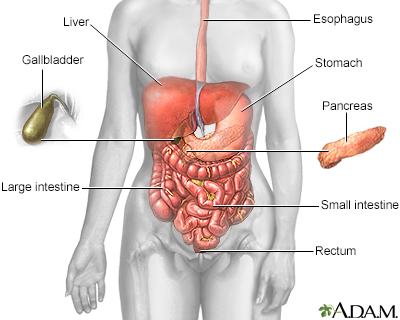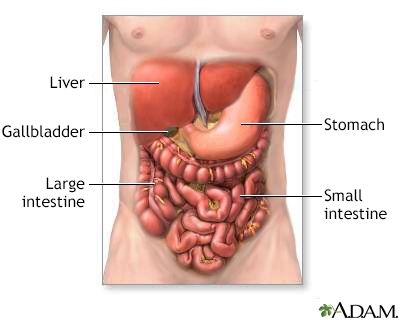Esophageal perforation
An esophageal perforation is a hole in the esophagus. The esophagus is the tube food passes through as it goes from the mouth to the stomach.
Causes
When there is a hole in the esophagus, the contents of the esophagus can pass into the surrounding area in the chest (mediastinum). This often results in infection of the mediastinum (mediastinitis).
Mediastinitis
Mediastinitis is swelling and irritation (inflammation) of the chest area between the lungs (mediastinum). This area contains the heart, large blood...

The most common cause of an esophageal perforation is injury during a medical procedure. However, the use of flexible instruments has made this problem uncommon.
The esophagus may also become perforated as the result of:
- A tumor
- Gastric reflux with ulceration
Gastric reflux
Gastroesophageal reflux disease (GERD) is a condition in which the stomach contents leak backward from the stomach into the esophagus (food pipe). F...
 ImageRead Article Now Book Mark Article
ImageRead Article Now Book Mark ArticleUlceration
An ulcer is a crater-like sore on the skin or mucous membrane. Ulcers form when the top layers of skin or tissue have been removed. They can occur ...
 ImageRead Article Now Book Mark Article
ImageRead Article Now Book Mark Article - Previous surgery on the esophagus
- Swallowing a foreign object or caustic chemicals, such as household cleaners, disk batteries, and battery acid
- Trauma or injury to the chest and esophagus
- Violent vomiting (Boerhaave syndrome)
Less common causes include injuries to the esophagus area (blunt trauma) and injury to the esophagus during surgery of another organ near the esophagus.
Symptoms
The main symptom is pain when the problem first occurs.
A perforation in the middle or lower most part of the esophagus may cause:
- Swallowing problems
Swallowing problems
Atelectasis is the collapse of part or, much less commonly, all of a lung.
 ImageRead Article Now Book Mark Article
ImageRead Article Now Book Mark Article - Chest pain
Chest pain
Chest pain is discomfort or pain that you feel anywhere along the front of your body between your neck and upper abdomen.
 ImageRead Article Now Book Mark Article
ImageRead Article Now Book Mark Article - Breathing problems
Breathing problems
Breathing difficulty may involve:Difficult breathing Uncomfortable breathingFeeling like you are not getting enough air
 ImageRead Article Now Book Mark Article
ImageRead Article Now Book Mark Article
Exams and Tests
Your health care provider will look for:
- Fast breathing
- Fever
Fever
Fever is the temporary increase in the body's temperature in response to a disease or illness. A child has a fever when the temperature is at or abov...
 ImageRead Article Now Book Mark Article
ImageRead Article Now Book Mark Article - Low blood pressure
Low blood pressure
Low blood pressure occurs when blood pressure is below normal. This means the heart, brain, and other parts of the body may not get enough blood. I...
 ImageRead Article Now Book Mark Article
ImageRead Article Now Book Mark Article - Rapid heart rate
- Neck pain or stiffness
- Air bubbles underneath the skin if the perforation is in the top part of the esophagus
You may have a chest x-ray to look for:
Chest x-ray
A chest x-ray is an x-ray of the chest, lungs, heart, large arteries, ribs, and diaphragm.

- Air in the soft tissues of the chest
- Fluid that has leaked from the esophagus into the space around the lungs
- Collapsed lung -- X-rays taken after you drink a non-harmful dye can help pinpoint the location of the perforation
You may also have a chest CT scan to look for an abscess in the chest or esophageal cancer.
Chest CT scan
A chest CT (computed tomography) scan is an imaging method that uses x-rays to create cross-sectional pictures of the chest and upper abdomen....

Abscess
An abscess is a collection of pus in any part of the body. In most cases, the area around an abscess is swollen and inflamed.

Treatment
You may need surgery. Surgery will depend on the location and size of the perforation. If surgery is needed, it is best done within 24 hours.
Treatment may include:
- Fluids given through a vein (IV)
- IV antibiotics to prevent or treat infection
- Draining of fluid around the lungs with a chest tube
- Mediastinoscopy to remove fluid that has collected in the area behind the breastbone and between the lungs (mediastinum)
Mediastinoscopy
Mediastinoscopy with biopsy is a procedure in which a lighted instrument (mediastinoscope) is inserted in the space in the chest between the lungs (m...
 ImageRead Article Now Book Mark Article
ImageRead Article Now Book Mark Article
A stent may be placed in the esophagus if only a small amount of fluid has leaked. This may help avoid surgery.
A perforation in the uppermost (neck region) part of the esophagus may heal by itself if you do not eat or drink for a period of time. In this case, you will need a stomach feeding tube or another way to get nutrients.
Surgery is often needed to repair a perforation in the middle or bottom portions of the esophagus. Depending on the extent of the problem, the leak may be treated by simple repair or by removing the esophagus.
Outlook (Prognosis)
The condition can progress to shock, or even death, if untreated.
Shock
Shock is a life-threatening condition that occurs when the body is not getting enough blood flow. Lack of blood flow means the cells and organs do n...

Outlook is good if the problem is found within 24 hours of it occurring. Most people survive when surgery is done within 24 hours. Survival rate goes down if you wait longer.
Possible Complications
Complications may include:
- Permanent damage to the esophagus (narrowing or stricture)
- Abscess formation in and around the esophagus
- Infection in and around the lungs
When to Contact a Medical Professional
Tell your provider right away if you develop chest pain or trouble breathing when you are already in the hospital.
Go to the emergency room or call 911 or the local emergency number if:
- You have recently had surgery or a tube placed in the esophagus and you have chest pain, problems swallowing, or breathing.
- You have another reason to suspect that you may have esophageal perforation.
Prevention
These injuries, although uncommon, are hard to prevent.
Reviewed By
Jenifer K. Lehrer, MD, Gastroenterologist, Philadelphia, PA. Review provided by VeriMed Healthcare Network. Also reviewed by David C. Dugdale, MD, Medical Director, Brenda Conaway, Editorial Director, and the A.D.A.M. Editorial team.
Muñoz-Largacha JA, Donahue JM. Management of esophageal perforation. In: Cameron J, ed. Current Surgical Therapy. 14th ed. Philadelphia, PA: Elsevier; 2023:74-80.
Raja AS. Thoracic trauma. In: Walls RM, ed. Rosen's Emergency Medicine: Concepts and Clinical Practice. 10th ed. Philadelphia, PA: Elsevier; 2023:chap 37.


 All rights reserved.
All rights reserved.